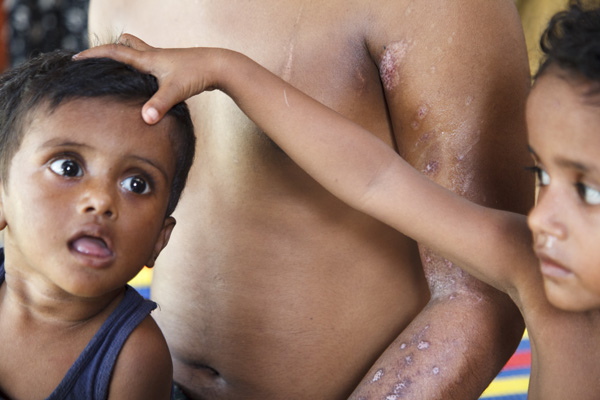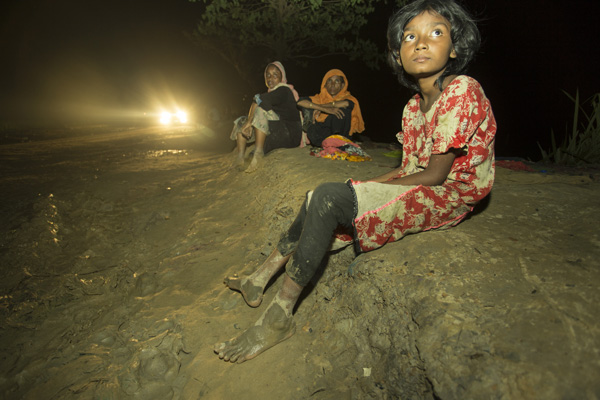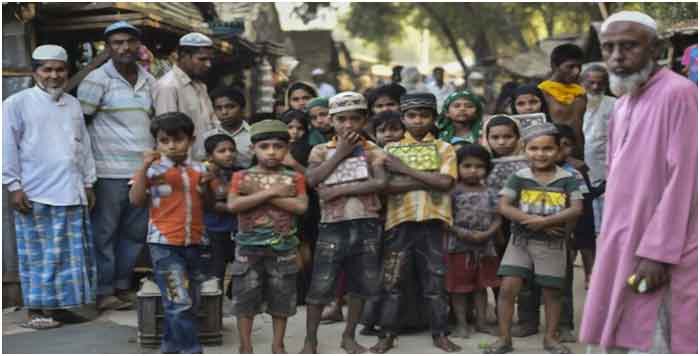21-22 September 2017; Tambru, Myanmar-Bangladesh border and Rohingya refugee camp in Ukhia, Cox’s Bazar, Bangladesh: ‘Refugee camps’ of sorts or just make shift shelters of “Rohingya” minorities of Myanmar, who have fled the genocide and ethnic cleansing perpetrated by the Myanmar army and majority population, have sprung up along the Bangladesh-Myanmar border. These camps are stretching from just outside of the barbwire fences erected by Myanmar government to the Bangladeshi territory across the no-man’s land. The persecuted and denied citizens of Myanmar are clinging there, still in fear, as the Burmese military regularly patrol the area and plant landmines to prevent them from any attempt to go back to their ancestral houses where they lived for generations. They also see the smoke from burning villages, the houses they have left behind and human corpses carried down by the streams, clear indications that the onslaughts they have fled are still continuing unabated. Along with it rumour and fear flies around. Almost one million of 1.1 to 1.2 million Rohingya sare now forced to leave their houses and take refuge in Bangladesh.


The attacks that drove them out were systematic and coordinated- both the military and majority Buddhist population took part in it. They torched down the Rohingya villages, rounded up the inhabitants, beaten them up indiscriminately,raped the women,chopped off their limbs, slaughtered few and the rest were allowed to flee. One pattern emerged from interviews with the victims that when houses were attacked they killed or injured one or few members of the family so that the others do not dare to stay in their homestead. We have found a small boy,aged 6, at Balukhali camp in Cox’s Bazar, who was shot at his hip while their house was attacked.Burmese military entered their house on 26th August afternoon and shot him from close range without provocation in front of his mother and four siblings. While his mother was crying to watch that they left warning her to leave the house without harming anyone else.

A farmer in a camp showed us the smoke bellowing up across the border and said that that was his homestead and being burned down. He added, during the earlier episodes of riots and persecutions of Rohingyasin the interiors of the country he thought they would not be affected in the fringes, at the remote border areas but when the current exodus started, and people from nearby villages were attacked they fled. He was looking grimly at the paddy fields he planted across the barbwire fence; someone suggested that when ripen he may harvest those in the darkness of the night; he was afraid of the landmines and military patrols.


Many of the families fled to the border or inside Bangladesh have lost some of its family members. They were either killed by the Myanmar military and the Burmese mob or separated from each other during their escape to safety. In many families father or mother could escape with children loosing the other partner. Some of the children lost both of the parents and left for fending themselves, which make them, particularly the girls, vulnerable to all kinds of abuse.
Some of the Rohingya endured through the previous attacks could not cling to their villages this time. One woman said she do not want to go back even- her houses at the north of Maungdaw was burned down few years back during another anti-Rohingya campaign. They stayed back but this time it was so violent and ruthless that they had to leave.She was staying at the border with several of the family members missing and waiting to enter Bangladeshi territory having no immediate intention to return. However, many others want to go back to their villages but only if their citizenship is given back and safety is guaranteed.
We met some young men in another camp- only two of them have passed secondary level (matriculation) in the school. One of them admitted for a graduation course but could not complete it due to previous violences.The higher education beyond secondary level is very rare. According to them, Rohingyas are systematically deprived of education along with other rights; getting admitted in the collages and universities is very tough for them. Only very few who are rich or have high political connections can access higher education. There is almost no political organization or leadership among them. Even those who try to build a career and rise in prominence as professional (let alone organising people or a political leader)are systematically eliminated.
The decades long persecution, deprivation, very low literacy rate, lack of voice, low access to useful information, superstition, lack of organization and leadership and indifference from international community has made them very vulnerable as a group to religious radicalization and misguiding towards extremism. The recent attack on Burmese military shows that this population have reached to their tipping point and taking matters in their own hands. They are inclining towards violent measures after enduring the genocide, ethnic cleansing and discrimination for decades, in the backdrop of complacency and inaction from the international community.
They have the only one lifeline;the single source of relief goods, medicines and treatments is across the border in Bangladesh. The Bangladesh government and its border guards are facilitating the delivery of food and other relief services, even to the no-man’s land- they handover the essential aids to the refugees who take it back to their families. However, it is unable to save them from land mines and any attack from the Myanmar regime.
Those who have managed to enter Bangladesh are secured from Burmese military and mob but far from being safe. While they were fleeing with their lives and belongings they were looted both in Myanmar and Bangladesh by local thugs. Their cattle and valuables were either snatched away or they were forced to sell those for trifle to the local vested groups.Our guide, a local ‘journalist’ who is also involved in relief distribution and refugee listing, were asking if a family in the no-man’s land would sell their motorbike. He was chattering about how cheap those bikes were and how easy it was to smuggle those in at night, as well as the cattle and other stuff.
He also tried to show us the photo of a “Rohingya diva”in his mobile phone and disappointed by our reluctance in all those. He was from a local influential family. The Rohingya women, particularly the good-looking young women, are very vulnerable to sexual abuse. The local men, pimps and human traffickers are on the prowl for them. Unfortunately they are not even safe from fellow refugee men. As, a large number of women and girls are separated from their family or living without the male family members, the situation is very dire.A local photographer told us that he photographed almost two dozens girls after their arrival but the prettier ones disappeared within three days and he could not trace them again.
The Bangladesh authority caught unguarded and concerned about the consequences of refugee problems including resource mobilisation, local social disruption and breeding of extremism, along with its impact on communal harmony in Bangladesh, is also struggling with the scale of the problem.Which is sometimes causing more plights to the refugees- they initially tried to remove all the refugees from the ethnically sensitive hill districts and ordered to send them to Cox’s Bazar districts. The law enforcement agencies forced them to dismantle makeshift shelters and move towards established camps in Cox’s Bazar. But the refugees suffered in the rough weather. Later the authorities restricted the movement of the refugees from the border areas to the interior; by this time some of the families shifted part of their belongings and family members to the camps elsewhere but due to that sudden restriction they were separated. They could not even communicate with the estranged family members.
Providing with sufficient aid to the refugees is another huge challenge for Bangladesh government, along with maintaining law and order and social stability in the area. Though there is an outpour of sympathy among the Bangladeshi population for the plight of Rohingya refugees and they are flocking from all over the country with relief, it is no match for the magnitude of the problem, especially in the medium and long term, when the public emotion will subside. When the citizens and groups are coming with relief goods it is often creating chaos while the refugees compete for it and putting the weaker ones at serious risk. The authority is trying to coordinate and control but it is clearly under resourced.
The sympathy among the Bangladeshi citizens often make them throwing money and goods from the vehicle at the Rohingyas waiting along the roads, the refugees rush together in a frenzy to collect those, this put them in serious risk of being stampeded or run over by a car.
The local people are already feeling the heat of the crisis- while they helped the refugees at the beginning, they are now claiming that the economic activities are disrupted and their income is going down, while the price of commodity has suddenly increased, raising their cost of living. We have seen some of the local shopkeeperswere wielding sticks to disperse refugees clogging their entrances.
It was also evident that the religious groups were more active in providing aid and relief works than any other crisis in the country. Authorities have already detained few of such groups in suspicion of political or radicalisation motives. Despite the vigilance of the Bangladesh government,because of the sheer numbers, there is a very real risk of such groups radicalising the Rohingya refugees, inspiring them the extremism and causing communal and political unrest within Bangladesh. If this huge number of persecuted and illiterate population with no hope for future in their own homeland are radicalised they will not only pose a serious threat to Bangladesh or Myanmar but may also be proved as a global problem greater than Syria.
Given the situation, there is very urgent need for the international community to act fast to stop state sponsored atrocities against Rohingyas and other communities in Myanmar and ensure immediate return of the refugees.Given the record of the Myanmar military and government, it is not only imperative to impose very strict military and arms embargo against them but also economic one. In addition, prosecution for genocide and ethnic cleansing should also be started. Above all, to ensure the safety of the Rohingyas and return of the refugees restoration of their Myanmar citizenship and deployment of an international peace keeping force in the Rohingya populated regions is of utmost importance.




Husband was killed by Myanmar military. She was beaten by the Burmese mob and drove her out towards Bangladesh border. She has pain in the body yet could not but waiting for relief by the road.





Abu Ala is a researcher and photographer with a Background in Anthropology and NGO sector. He is currently working as an independent professional. All photographs by Abu Ala
















































